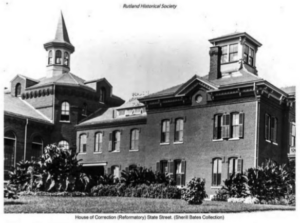 “Paternity Concealed & Revealed: The Case of Julia Smith of Rutland, Vermont,” published in American Ancestors, recounts one of my wildest rides in Vermont research.[i] Why did Julia Smith of Rutland hide her true identity? My investigation proved that Julia was the daughter of English convict Emanuel Abrahams, a London Jew, who spent two decades in Queen Victoria’s prisons. After emigrating to Vermont in the late 1870s, Emanuel assumed the name John Smith and married Mary Dougherty, an Irish Catholic, twenty-five years his junior—theirs an unlikely union for that time, with disparities of culture, religion, and age.
“Paternity Concealed & Revealed: The Case of Julia Smith of Rutland, Vermont,” published in American Ancestors, recounts one of my wildest rides in Vermont research.[i] Why did Julia Smith of Rutland hide her true identity? My investigation proved that Julia was the daughter of English convict Emanuel Abrahams, a London Jew, who spent two decades in Queen Victoria’s prisons. After emigrating to Vermont in the late 1870s, Emanuel assumed the name John Smith and married Mary Dougherty, an Irish Catholic, twenty-five years his junior—theirs an unlikely union for that time, with disparities of culture, religion, and age.
My article left a couple of disconnected puzzle pieces. The first: Why was Julia baptized at the age of five in Rutland’s St. Peter’s Catholic Church on 29 May 1886, with her grandmother Margaret Dougherty acting as her sponsor? Julia lived with her grandmother henceforth. Since Catholic babies were usually baptized soon after birth, the delay could be explained by the fact that Julia was not the child of a legitimate marriage. If her mother were dead, that would allow Julia’s grandmother to raise her as Catholic. Moreover, I speculated that Julia’s father, with a long record of crime and duplicity, had abandoned his daughter. Absence of any death records perplexed me all the more because the family lived only two blocks distant from Rutland Town Hall.
Thus, this mystery simmered for several years until I finally heeded the ad on the front page of the Rutland Herald touting its online archive back to 1794: “Use the archive to remember the past and learn about our history.” Who would have thought that entering John Smith in the search box would have produced this result?
Struggle with a Vixen: Mary Dougherty Smith, a notorious character, and wife of John Smith, was arrested yesterday for disturbing the peace and drunkenness, She came up to the village and went to the rag room in Dunn & Cramton’s store, where her husband worked, made a fierce attack upon him, knocking him down and bruising him considerably.[ii]
The news story ends with Mary being sent to the Rutland House of Correction, where she spent most of the last two years. Note this altercation took place two weeks before Julia’s baptism, thereby establishing new context. My previous conclusion in assuming Emanuel was the villain proved erroneous because he was the victim, not the perpetrator, in this instance.
Other news stories from the Rutland Daily Herald revealed more about Mary and her aliases. She became known as “Billie Dougherty,” as one headline described her as “jugged [arrested] again,” referring to ten different prison sentences in the last eight years.[iii]
Mary aka Billie came to a violent end. On Monday, 20 May 1889, “having imbibed rather freely” and “acting in a boisterous manner,” she left Rutland on the evening train to Whitehall, New York. As a locomotive reversed on the track to dump ashes, the train backed over Mary twice before realizing the woman had been killed. Her mangled body was returned by train to Rutland on the next day.[iv] Mary’s death and place of burial went unrecorded in Rutland records. She is likely buried in an unmarked grave in the prison cemetery.
Had this archive been available at the time of my initial research, the story would have been told differently. As newspaper digitization continues, it creates opportunities for us to revisit incomplete chapters of genealogy. Julia’s father, Emanuel Abrahams, still remains lost to history after 1886 but, now, I have more hope in discovering the rest of his story.
Notes
[i] Michael F. Dwyer, “Paternity Concealed & Revealed: The Case of Julia Smith of Rutland, Vermont,” American Ancestors 17 [2016]: 30–34.
[ii] “Struggle with a Vixen,” Rutland Daily Herald, 13 May 1886, 4.
[iii] “Billie Dougherty Jugged Again,” Rutland Daily Herald, 14 September 1888, 4.
[iv] “Poor Billy. Tragic End of the Ill-Spent Life of Mrs. Mary Smith,” Rutland Weekly Herald, 23 May 1889, 6.
Share this:

About Michael Dwyer
Michael F. Dwyer first joined NEHGS on a student membership. A Fellow of the American Society of Genealogists, he writes a bimonthly column on Lost Names in Vermont—French Canadian names that have been changed. His articles have been published in the Register, American Ancestors, The American Genealogist, The Maine Genealogist, and Rhode Island Roots, among others. The Vermont Department of Education's 2004 Teacher of the Year, Michael retired in June 2018 after 35 years of teaching subjects he loves—English and history.View all posts by Michael Dwyer →